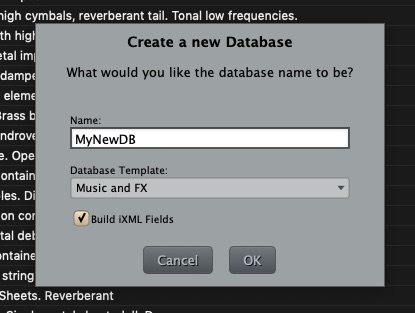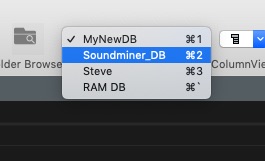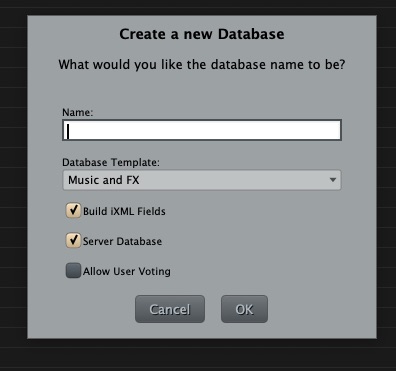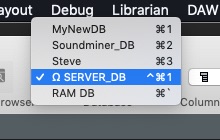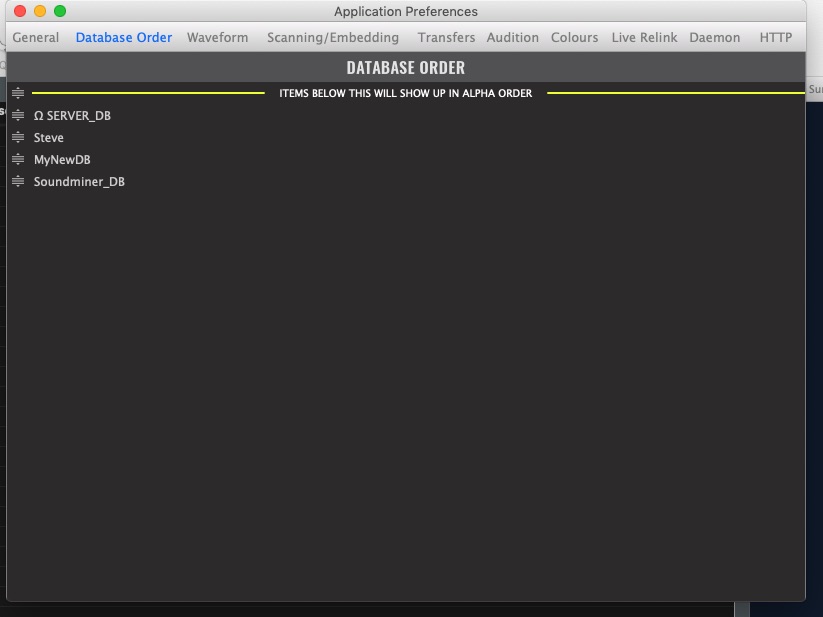Create a Database
Your first launch will automatically create an empty database named “Soundminer DB.” To create a new database, go to the DATABASE menu and select CREATE DATABASE, give your Database a name(do not start the name with numbers). By selecting a preferred template, you can create databases optimized for specific functions – ie. Music versus Sound Effects vs Dialog.
In other words, when creating databases you have the ability to choose from multiple templates: Sound Effects(doesn’t have fields like Composer, Publisher, BPM,etc), Music (doesn’t have fields like microphone, rectype, etc), or Dialog(has iXML field recorder fields like tape, tape speed, time code format). If you are connected to a Soundminer Server, you may also have the option to create a Server database (provided those permissions were granted to you) and create custom fields in addition.
If unsure, select the Music and FX template to get most local fields as you cannot add fields after creation(except on Server DBs). Version V5pro also offers a custom template option. Soundmimer can create custom templates for any client(fees apply).
Once you hit OK, the database as you have named it will appear in the database selector of the Toolbar/Find section. You can have as many databases as you want, and you can switch between databases by clicking on the pull-down menu in the database selector(quick key commands cmd+number).
To really speed up database searches, you want the Soundminer Support folder, which holds databases and everything else on an SSD drive. The startup drive is usally used to hold your databases, but you can move them to an external drive if its fast enough.
IXML fields - when this is checked, the database adds fields specific to that standard used by location recorders. If working with field recordings you should turn this on.
Server Databases
If you have Soundminer server, the creating a database pane will contain an additional check box:
By checking that off(and assuming you have permissions to create new databases) hitting OK will create a database on the Server that can be shared and be visually noted with the Omega sign in front of its name:
Allow User Voting - when enabled, users can tick off whether a file is good or not as a way of denoting quality among the shared group.
Once you create numerous databases, you may wish to organize them by priority and that can be done in the preferences:
Database V5Pro Templates
The code and framework has been changed here to better deal with both things like iXML, as well as custom schemas. Built into the framework is the ability to create your own custom templates beyond Music and FX. While not exposed to the user, the new framework now allows for this. At the moment, for any user who needs to create their own schema, they should contact support@soundminer.com. There would be a customization charge for this kind of work.
RAM Database - what is that?
A RAM database is always present as a temporary area where you can scan in files for whatever reason without having to make a permanent database. It flushes content on restart, and whenever a new scan is initiated and ideally suited for testing or a scratch pad area while working.
© 2020 Soundminer Inc.
